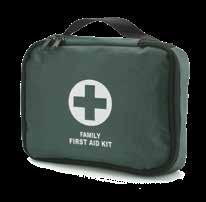
2 minute read
Create a disaster survival kit
Onceyou can return to your home after an evacuation or after a disaster, you’ll need food and supplies on hand as power, water and gas may be out for extended periods of time and there may be limited resources, like food, available. You should also keep a kit prepared for winter disasters. – KATHERINE E.
HILL
Advertisement
Basic Supplies
• Water. 1 gallon per person, per day, 2-week supply. Include water for pets.
• Food. 2-week supply of non-perishable, easy-toprepare items.
Manual can opener if using canned items.
• Portable gas stove with extra canisters
• Flashlight
• Battery-powered, solar or hand-cranked radio
• Extra batteries
• First aid kit
• Know CPR. Take a class, if needed. Visit redcross. org.
• Medications & medical supplies. 2-week supply including hearing aid batteries, glasses, syringes, etc.
• Baby supplies. Bottles and 2-week supply of formula, baby food, diapers, etc.
• Multi-purpose tool
• Sanitation & personal hygiene items
• Extra cash
• Copies of personal documents (medication list and pertinent medical information, proof of address, deed/lease to home, passports, birth certificates, insurance policies)
• Cell phone with chargers, including a solar or battery-operated charger
• Family & emergency contact information (paper copy)
• Emergency blankets or sleeping bags
• Paper maps of the area
• Games & activities for children
• Pet supplies with 2 weeks of food
• Two-way radios
• Extra set of car & house keys
• Whistle
• Face masks
• Matches in a waterproof container
• Rain gear
• Towels
• Work gloves
• Tools & supplies for securing your home
• Extra clothing, hat & sturdy shoes
• Plastic sheeting
• Duct tape
• Scissors
• Household liquid bleach

• Fire extinguisher (know how to use it)
• Disposable paper plates, cups & utensils (biodegradable preferred)
• Moist towelettes, garbage bags & plastic ties for personal sanitation
• Non-sparking wrench & pliers for turning off utilities
• Locate all utilities shut offs in advance and know how to turn them off
Make A First Aid Kit

(For a family of 4)
• Required medications & medical supplies for family members
• 2 absorbent compress dressings (5 x 9 inches)
• 25 adhesive bandages (assorted sizes)
• 1 adhesive cloth tape (10 yards x 1 inch)
• 5 antibiotic ointment packets
• 5 antiseptic wipe packets
• 2 packets of aspirin (81 mg each)
• 1 emergency blanket
• 1 breathing barrier (with one-way valve)
• 1 instant cold compress
• 2 pair of nonlatex gloves (size to fit adults)
• 2 hydrocortisone ointment packets
• 1 3 in. gauze roll (roller) bandage
• 1 roller bandage (4 inches wide)
• 5 3 in. x 3 in. sterile gauze pads
• 5 sterile gauze pads (4 x 4 inches)
• Oral thermometer (non-mercury/nonglass)
• 2 triangular bandages
• Tweezers
• Emergency First Aid guide (paper)
Check the kit regularly & replace expired items.
Always keep a sturdy pair of shoes and a flashlight near your bed and handy in case of a sudden evacuation at night.
Preserve water for firefighters
Water
purveyors around Lake Tahoe are reporting an alarming trend of residents leaving irrigation, garden hoses and sprinklers on roofs actively running when they evacuate their homes. Not only is this not helpful in protecting homes from wildfire, but it can be detrimental for firefighters who rely on a water supply with adequate water flow to fight fire in extremely dangerous conditions, according to a press release from North Tahoe Fire Protection District. As a result, Lake Tahoe utility districts and water purveyors are exper-iencing a huge draw-down in water supplies and wells are pumping at maximum capacity throughout the area, even in evacuated areas that should be empty of residents. This can leave tanks dangerously low when firefighters need fast access to water from fire hydrants to protect homes.
Residents are also calling fire districts to ask if they should spray down roofs and vegetation before evacuating. This is not effective, as the roof will dry quickly, as will the vegetation, which doesn’t protect the home itself. Wide-scale activation of sprinklers and garden hoses dramatically reduces water pressure in the entire region. Evacuation preparedness efforts are better spent on removing combustible material away from homes. | Resources tahoelivingwithfire.com n





